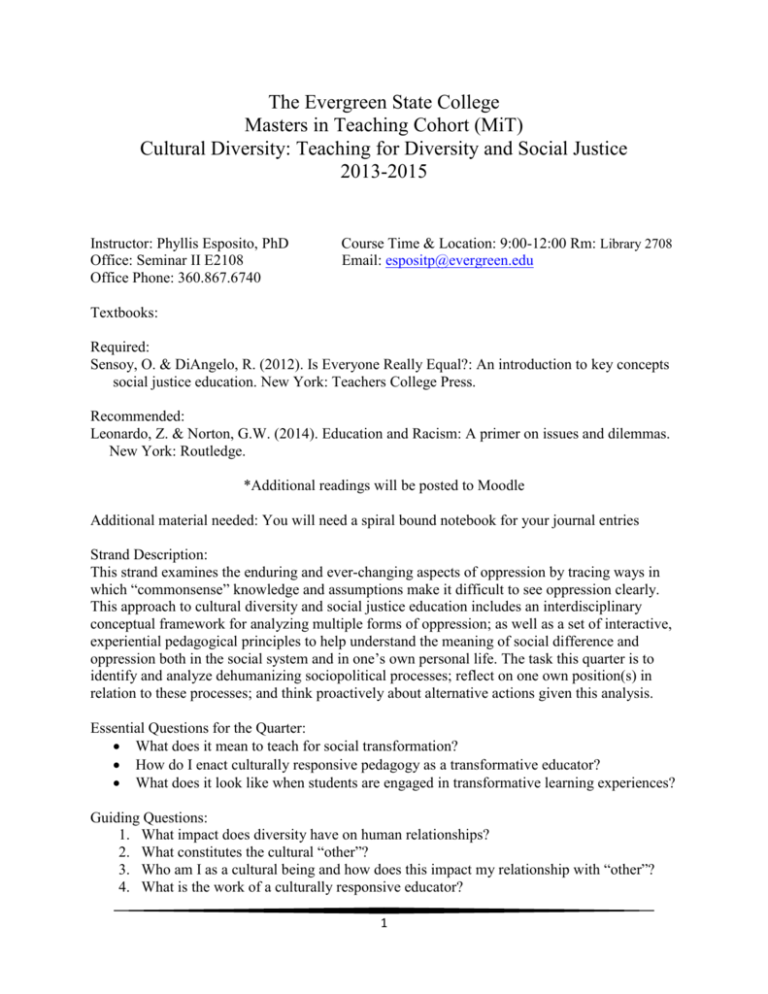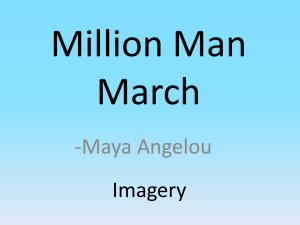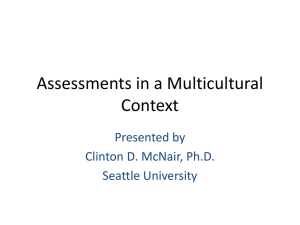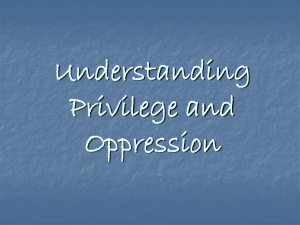Cultural Diversity Syllabus - a blog
advertisement

The Evergreen State College Masters in Teaching Cohort (MiT) Cultural Diversity: Teaching for Diversity and Social Justice 2013-2015 Instructor: Phyllis Esposito, PhD Office: Seminar II E2108 Office Phone: 360.867.6740 Course Time & Location: 9:00-12:00 Rm: Library 2708 Email: espositp@evergreen.edu Textbooks: Required: Sensoy, O. & DiAngelo, R. (2012). Is Everyone Really Equal?: An introduction to key concepts social justice education. New York: Teachers College Press. Recommended: Leonardo, Z. & Norton, G.W. (2014). Education and Racism: A primer on issues and dilemmas. New York: Routledge. *Additional readings will be posted to Moodle Additional material needed: You will need a spiral bound notebook for your journal entries Strand Description: This strand examines the enduring and ever-changing aspects of oppression by tracing ways in which “commonsense” knowledge and assumptions make it difficult to see oppression clearly. This approach to cultural diversity and social justice education includes an interdisciplinary conceptual framework for analyzing multiple forms of oppression; as well as a set of interactive, experiential pedagogical principles to help understand the meaning of social difference and oppression both in the social system and in one’s own personal life. The task this quarter is to identify and analyze dehumanizing sociopolitical processes; reflect on one own position(s) in relation to these processes; and think proactively about alternative actions given this analysis. Essential Questions for the Quarter: What does it mean to teach for social transformation? How do I enact culturally responsive pedagogy as a transformative educator? What does it look like when students are engaged in transformative learning experiences? Guiding Questions: 1. What impact does diversity have on human relationships? 2. What constitutes the cultural “other”? 3. Who am I as a cultural being and how does this impact my relationship with “other”? 4. What is the work of a culturally responsive educator? 1 Washington Standards for Teachers-Standard V Effective Teaching 5.A. Using multiple instructional strategies, including the principles of second language acquisition, to address student academic language ability levels and cultural and linguistic backgrounds. 5.B. Applying principles of differentiated instruction, including theories of language acquisition, stages of language, and academic language development, in the integration of subject matter across the content areas of reading, mathematical, scientific, and aesthetic reasoning. 5.C. Using standards-based assessment that is systematically analyzed using multiple formative, summative, and self-assessment strategies to monitor and improve instruction. 5.D. Implementing classroom/school centered instruction, including sheltered instruction that is connected to communities within the classroom and the school, and includes knowledge and skills for working with other. 5.E. Planning and/or adapting standards-based curricula that are personalized to the diverse needs of each student. 5.F. Aligning instruction to the learning standards and outcomes so all students know the learning targets and their progress toward meeting them. 5.G. Planning and/or adapting curricula that are standards driven so students develop understanding and problem-solving expertise in the content area(s) using reading, written and oral communication, and technology. 5.H. Preparing students to be responsible citizens for an environmentally sustainable, globally interconnected, and diverse society. 5.I. Planning and/or adapting learner centered curricula that engage students in a variety of culturally responsive, developmentally, and age appropriate strategies. Professional Development 5.L Developing reflective, collaborative, professional growth-centered practices through regularly evaluating the effects of his/her teaching through feedback and reflection. Teaching as a Profession 5.M Participating collaboratively and professionally in school activities and using 2 appropriate and respectful verbal and written communication. Assignments Weekly Readings The readings for this quarter will be from Sensoy and DiAngelo text. In addition, there will be additional readings posted on Moodle on the weeks indicated. Readings should be completed prior to the workshop. You will be expected to read and relate to each form of oppression covered in class and to be prepared both to discuss them in small groups, and to share highlights of your small group discussions with the rest of the class. As you read, keep the Reading Guideline Questions and these concepts in mind. In addition to being prepared to discuss the readings and related concepts in class, each group will be responsible to contribute at least one example of that form of oppression from current events. This can be in the form of a newspaper or magazine article, TV or radio news story, something that you have personally experienced or other sources that you identify. Please focus on current events. Group reading discussions should focus on three components: General reactions, based on the Reading Guideline Questions. The conceptual framework(s) related to that form of oppression, and how the readings illustrate them. Current events and manifestations of that form of oppression. Reading Guideline Questions What in the readings was particularly interesting, surprised you, or was new information to you? What are some things that you agree with or identify with? Explain how and why. What are some things you disagree with? Explain how and why. In what ways might the information in the reading be useful to you? How do the readings illustrate the conceptual frameworks? What questions do you still have about this form of oppression and/or the conceptual frameworks? Shared Journal Assignment The purpose of this assignment is to provide opportunities to participate in a written exchange of ideas with a peer in order to think reflexively (unpack) significant topics discussed during class. The prompts are grounded in the readings and the classroom experiences, but are particularly draw from the Sensoy and DiAngelo work as well as the readings from Howard. The Howard sections are posted on Moodle. 3 Respond to each element of the prompt. Arrange with your partner a mechanism to exchange your journals. For each week listed below you will respond to the prompt, exchange journals respond and comment on your partner’s thoughts. This should look like an ongoing dialogue which documents each partner’s personal growth and development over the course of the quarter. Prompts Week 2 What would it take for you to talk together more openly and deeply about issues of race and other differences? What are your concerns/hopes/expectations for this course? What have been your own formative experiences related to issues of diversity? Week 3 What were your feelings/thoughts as you read and listen to the author’s account of White social dominance as it affected Native Americans and Australian Aboriginals? How is the experience of Indigenous peoples in relationships to social dominance similar to that of other/ethnic/cultural groups? How is it unique What do you see as the relationship between social dominance and today’s concerns about educational equity and closing the achievement gap? Week 4 What are the three dynamics of dominance: the Assumption of Rightness, the Luxury of Ignorance, and the Legacy of Privilege? What do these terms mean to you? How do you see these three dynamics of dominance at play in classrooms, social systems and the politics of education today? Do you agree or disagree with the author’s analysis of social dominance? Why? Week 5 Mid-quarter Shared Journal Due-Bring journals to class Week 6 In what ways does the metaphor of the river work or not work for you? Compare and contrast your reactions to the author’s four “healing responses”: Honesty, Empathy, Advocacy, and Action. Week 7 What are the most important learnings/challenges/roadblocks/experiences for a person in growing toward greater cultural competence and understanding socially constructed differences? How are these stages similar to or different from the experiences and challenges of People of Color in your growth and development? Week 8 4 In personal reflection, map the stages/steps in your own development related to the realities of social constructed differences? What does the author mean by knowing and doing? Select one of the elements that particularly speak to you and share your thoughts and reflections. Reflect on Figures 7.1, 7.2, and 7.3. How do these models relate to your own thoughts about teaching? What is helpful about these designs? What is missing? Week 9 What was your reaction to the description of “the place of vision, healing, and positive change”? What do we need from each other if we are to create spaces of trust and effective collaboration in the service to our students? How do we (can we) move beyond shame and blame and actually create schools as places of hope and healing? Week 10 Final Shared Journal Due in Class Multicultural Perspective Paper Advice to Yourself as a New Teacher: Developing a Multicultural Perspective for Teaching for Social Justice A multicultural perspective is a statement that educators write to identify how they make sense of the purpose of education and their role as teachers. It will often describe how they approach their teaching practice in light of their understanding of the learning process, and the needs of learners, communities and society. Developing such a statement can help educators to steer their teaching decisions. It can also help them to communicate something about the reasons behind their practices to students, to families and potential employers. As a second step in developing your multicultural perspective, you will write an academic essay in which you use the professional literature to describe what teaching for social justice entails. Your paper should: Identify how power, privilege and oppression can play out in learning opportunities, curriculum, and schools. Recognize how power is at play in schools that reflect inequities based on race, class, language, gender, sexual orientation, religion, ability. Identify and explain how power, privilege and oppression can act as barriers to some people’s success (i.e. make learning less accessible) Use examples from your field experience, readings or other classroom experiences to illustrate how these principles and guidelines might look for the teacher, students, and families Use this knowledge to identify principles and guidelines for attending to equity and responding to potential inequities. Include specific ways you could adapt your curriculum, 5 instruction, advocacy, and self-reflections to make the learning more accessible and equitable. Note: There are many reasons why learning isn’t always accessible -- in this paper, focus on socio-cultural perspectives that we have learned about. Last quarter you learned about cognitive and neuroscience perspectives. Additional expectations for the paper: Use a range of perspectives to inform your discussion Use specific citations from this program’s readings to support your claims. The paper should be no longer than seven pages, 12 point font, double spaced. Use APA style for in text citations. Include a reference list formatted in APA style. Expectations for the process of writing the paper Use the drafting and peer review process. Write author’s notes to show how direct and make use of the feedback. Use the rubric faculty will use to evaluate your paper to inform your self assessment and revision process. 6 Tentative Calendar *Please note the syllabus is subject to change All Readings should be complete before scheduled workshop session Week Topic/Activity Week 1 Course Introductions Review Syllabus Setting Norms for Critical Discussions Week 2 Conceptual Foundations for Social Justice Education Theoretical Frameworks for Social Justice Education Dominance in the West Workshop Presenter: Frances Rains (MiT) Week 3 Week 4 Week 5 Twenty-First Race Oppression Workshop Power of the Illusion (Video) Sexism, Heterosexism and Transgender Oppression Workshop Workshop Panel: Week 6 Classism Oppression Workshop Week 7 Religion Oppression Workshop Week 8 Ableism Oppression Workshop Week 9 What? So What? Now What? Social Transformation and Culturally Responsive Teaching In-Class Peer Review of Multicultural Perspective Paper Review Learning Outcomes Evaluation Close Week 10 7 Assignments Read:(S) Prologue-chap. 3 Read: (H) chap. 1 Read: (S) Chaps. 4 & 5 Read:(H) Chap. 2 Read:(S) Chap. 7 Read:(H) Chap. 3 Read: (S) Chap. 6 Mid-quarter Review Shared Journal Due Read (H) Chap. 4 Read TBA Read: (H) Chap. 6 Read TBA Read: (H) Chap 7 Read: TBA Read (H) Chap. 8 High Quality Draft of Multicultural Perspective Final Draft of Multicultural Perspective







